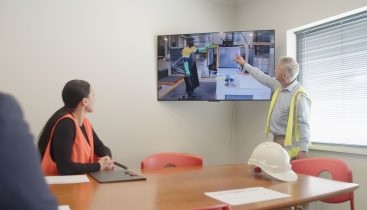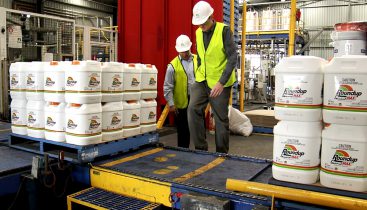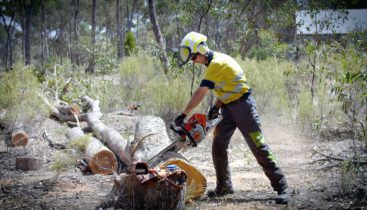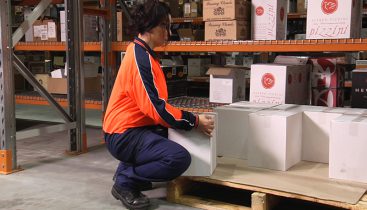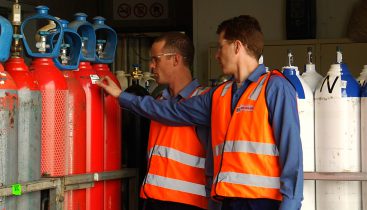Safety Training Videos
A Safetyhub subscription gives you access to every one of the safety training videos available on Safetyhub – so you can easily create a comprehensive safety training program tailored to the exact needs of your organization.

All Safetyhub videos are also available in French.
Check out our large selection of Microlearning content.
SCORM compliant files available on request.
Get access to all safety training videos on Safetyhub with a free trial subscription.
Behavioral Safety
Behavior Based Safety aims at reducing the incidence of unsafe acts by observing tasks, identifying causes of unsafe behavior, and implementing programs to motivate workers to perform safe practices when not being observed.
Our Online DEI Training for Employees is a 12-minute video course teaching diversity and inclusion. It covers risks of poor DEI, like legal issues, and strategies like equitable hiring to build an inclusive workplace, boosting engagement and innovation.
Our Online Harassment Training for Employees provides essential guidance on recognising, preventing and addressing sexual harassment in the workplace. Through engaging video content, employees learn about unacceptable behaviours, the impact of harassment, and practical steps to foster a respectful and inclusive work environment.
Our Contractor Management Online Video Course teaches essential contractor safety management, including risk assessment, safety inductions, task creep management and compliance. Ideal for safety managers, supervisors and project leads committed to a safer workplace.
This program examines hows stress can affect members of an organisation as well methods for combating it. Awareness of potential risks and moving proactively to prevent stress taking hold, will help minimise the chances of stress-related illness.
Unsafe acts occur in every workplace, and they occur, the more likely accidents and health problems will result. This program examines the reasons for the occurrence of unsafe acts and methods that can be used to reduce their frequency.
Understanding Safety Awareness is a program that has been designed for all personnel. It can be used as a general safety training program and can also be utilised as an induction program for new personnel to introduce safety concepts.
This course looks at understanding hazards and risks in the workplace. The process of hazard identification and evaluation, often referred to as risk assessment is so important that it is vital that everyone fully understands the meaning of the words.
COVID-19 Management
Behavior Based Safety aims at reducing the incidence of unsafe acts by observing tasks, identifying causes of unsafe behavior, and implementing programs to motivate workers to perform safe practices when not being observed.
Safe driving is a must under any circumstance, given the potential serious consequences of vehicle accidents. Winter conditions present additional challenges that must be properly understood and prepared for whenever driving takes place.
A Job Hazard Analysis, or JHA, is a method for examining a particular job so that the hazards and risks can be identified before they occur.
Working in environments of extreme temperature present unique safety issues that have an impact not only on the way a job is done, but also the hazards the individual completing the job is exposed to.
Our Online DEI Training for Employees is a 12-minute video course teaching diversity and inclusion. It covers risks of poor DEI, like legal issues, and strategies like equitable hiring to build an inclusive workplace, boosting engagement and innovation.
Trenching and excavation work presents serious hazards, including cave-ins, falling loads and hazardous atmospheres. Our Trenching and Excavation Training Online provides essential knowledge on hazard identification, protective systems and best practices to ensure worker safety. Through engaging video content and expert guidance, employees will learn about soil classification, shoring and shielding techniques, safe access requirements and emergency procedures.
Silica dust is a serious workplace hazard that can cause lung disease, cancer and other health complications. Our Silica Awareness Training educates workers on the dangers of silica exposure and provides essential strategies to minimise risks. Through engaging video content, employees will learn about effective control measures, proper use of PPE and best practices for maintaining a safe work environment.
Our Online Harassment Training for Employees provides essential guidance on recognising, preventing and addressing sexual harassment in the workplace. Through engaging video content, employees learn about unacceptable behaviours, the impact of harassment, and practical steps to foster a respectful and inclusive work environment.
Falls and Heights
This programs highlights the major hazard areas associated with slips, trips and fall incidents in the workplace. It looks at key hazards and increases awareness of standards for worker responsibility in observing and being active in daily safety procedures.
Suitable for all workplace personnel, the aim of this video based training program is to improve the participants understanding about the subject of falls in the workplace and to specifically identify control measures that will prevent fall type accidents.
Falls represent the largest single cause of accidental death in the workplace. This program looks at the selection and safe use of ladders in the workplace. The safety training video has been designed for general training for all personnel who use ladders.
Fire Awareness
This program looks at a simple scientific explanation of fire, Identification of common workplace hazards associated with fires and fire behaviour characteristics. The program concludes with identifying oxygen deprivation as the major cause of fire related deaths.
This safety training course addresses fire extinguisher training requirements; information a person needs to know in order to select and safely use a portable fire extinguisher in the workplace, helping to control a fire both quickly and safely.
Following Safe Work Practices lessens the chance of fires and explosions occurring. This program examines scientific facts about how fire and flammable vapors behave as well as procedures that can be implemented to prevent the occurrence of fires.
The burns training program examines the principles of first aid treatment for burns victims. The program illustrates the need for recognition, evaluation and control of hazards that may lead to burns injuries and what to do in a burn emergency.
There are many reasons why a building or a group of buildings may need to be evacuated. Every organisation should have a tried and tested evacuation plan. This program covers the evacuation plan, the team, responsibilities, training and practice
This program examines the emergency preparedness strategy that should be adopted to deal with bomb threat or placement situations. This program has been produced to be shown to all personnel who may become involved in a bomb threat incident.
Good housekeeping is an ongoing responsibility of everyone in the workplace. Workplace housekeeping safety training helps to reduce the number of accidents and injuries occurring. It also decreases the risk of fires occurring in the workplace.
The program provides a practical understanding of static electricity and examines potential hazards and ways to control static electricity. The safety video covers important safety precautions that should be followed when working in flammable atmospheres.
First Aid and Wellness
Our Online DEI Training for Employees is a 12-minute video course teaching diversity and inclusion. It covers risks of poor DEI, like legal issues, and strategies like equitable hiring to build an inclusive workplace, boosting engagement and innovation.
Silica dust is a serious workplace hazard that can cause lung disease, cancer and other health complications. Our Silica Awareness Training educates workers on the dangers of silica exposure and provides essential strategies to minimise risks. Through engaging video content, employees will learn about effective control measures, proper use of PPE and best practices for maintaining a safe work environment.
Our Online Harassment Training for Employees provides essential guidance on recognising, preventing and addressing sexual harassment in the workplace. Through engaging video content, employees learn about unacceptable behaviours, the impact of harassment, and practical steps to foster a respectful and inclusive work environment.
Our Legionella Safety Training provides essential knowledge on Legionella risks, prevention and compliance. Learn how to identify hazards and implement control measures to protect employees and ensure workplace safety.
Active Shooter Training Online includes comprehensive guidance on ‘Run, Hide, Fight’ strategies, attack awareness, escape planning, hiding techniques, and self-defense tips to ensure workplace safety during emergencies.
Working from home is the practice of engaging in work without commuting to an established location such as an office, a facility, a complex or a campus. A healthy and safe environment should be the goal for all people working from home safely.
This program examines hows stress can affect members of an organisation as well methods for combating it. Awareness of potential risks and moving proactively to prevent stress taking hold, will help minimise the chances of stress-related illness.
This program looks at the relationship between people, the equipment they use and the physical environment in which they work. The program forms an introduction to ergonomics reinforces the principles employed to address ergonomic problems.
Forklifts and Cranes
The Slings training program looks at a range of lifting equipment and the fundamental principles that should be followed to prevent accidents. This video is concerned with the slings and ancillary gear used in conjunction with the main lifting equipment.
This video program has been designed to clearly identify all the steps necessary to enable efficient and safe operation of any overhead crane. This program looks at the safe operation of overhead cranes and details the five major steps to ensure their safe use.
The objective of the forklift safety training program is to highlight the importance of operating Forklifts safely and in so doing, increase awareness of the standards for worker responsibility in observing and being active in daily safety procedures.
Hand and Power Tools
'Chainsaws: Safe Cutting' teaches safe cutting techniques - focusing on avoiding kickback, proper body positioning and efficient methods for limbing, cross-cutting and felling trees. Ideal for chainsaw operators of all skill levels.
This course provides detailed training on chainsaw parts and components, covering the engine, guide bar, saw chain, cutter profiles, safety features and maintenance practices to enhance workplace safety and equipment performance.
Power Tools Safety Training shows operators how to get the best out of their Power Tools and how to use them effectively and safely. The tools covered in this program include Power Drills, Belt and Orbital Sanders, Power Planers and Jig and Circular Saws.
Our Chainsaw Safety Training video covers essential chainsaw maintenance and chainsaw safety practices. Learn chain sharpening, guide bar care, proper chain tensioning, and fuel preparation to keep your equipment in top condition and reduce risks.
The angle grinder safety program is aimed at professional and non-professional operators of Angle Grinders as a safety and operational guide. This program includes Types of Angle Grinders, Pre-Use Checks, Safe Operation, Disc Shatter and Kick Back.
Our Chainsaw Basics Safety Training video covers essential safety practices, including PPE, pre-operation checks, fueling, starting techniques and proper handling. Equip your team with the knowledge to operate chainsaws safely and confidently.
By increasing awareness of the dangers of compressed air, the risk of injuries can be reduced and workplace safety can be improved. The program provides people with a practical understanding of how compressed air works and why it is dangerous.
Off-hand Grinding machines are widely used throughout industry. This program shows how to operate an off-hand grinding machine safely and efficiently and is aimed at professional and non-professional operators as a safety and operational guide.
Hazardous Environments
Safe driving is a must under any circumstance, given the potential serious consequences of vehicle accidents. Winter conditions present additional challenges that must be properly understood and prepared for whenever driving takes place.
Working in environments of extreme temperature present unique safety issues that have an impact not only on the way a job is done, but also the hazards the individual completing the job is exposed to.
Trenching and excavation work presents serious hazards, including cave-ins, falling loads and hazardous atmospheres. Our Trenching and Excavation Training Online provides essential knowledge on hazard identification, protective systems and best practices to ensure worker safety. Through engaging video content and expert guidance, employees will learn about soil classification, shoring and shielding techniques, safe access requirements and emergency procedures.
Silica dust is a serious workplace hazard that can cause lung disease, cancer and other health complications. Our Silica Awareness Training educates workers on the dangers of silica exposure and provides essential strategies to minimise risks. Through engaging video content, employees will learn about effective control measures, proper use of PPE and best practices for maintaining a safe work environment.
Our Contractor Management Online Video Course teaches essential contractor safety management, including risk assessment, safety inductions, task creep management and compliance. Ideal for safety managers, supervisors and project leads committed to a safer workplace.
Our WHMIS online course provides up-to-date training on WHMIS 2023, covering hazard classification, labelling, Safety Data Sheets (SDS), PPE and GHS standards. This flexible and accessible video course helps employees understand WHMIS regulations, helps your business stay compliant and ultimately better maintain a safe workplace.
Safety risks in commercial kitchens can be minimised when proper attention is paid to workplace health and safety. The likelihood of accidents and injuries in a kitchen can be greatly reduced by implementing safe work practices and procedures, including hazards training, food handling, hygiene, control measures and working safely with heat.
Adherence to thoroughly considered policy and procedures, can play a large part in preventing accidents and injuries in a warehouse. This Warehouse Safety program examines the various hazards that exist in a warehouse and how best to avoid them.
Hazardous Substances
Our WHMIS online course provides up-to-date training on WHMIS 2023, covering hazard classification, labelling, Safety Data Sheets (SDS), PPE and GHS standards. This flexible and accessible video course helps employees understand WHMIS regulations, helps your business stay compliant and ultimately better maintain a safe workplace.
Safety risks in commercial kitchens can be minimised when proper attention is paid to workplace health and safety. The likelihood of accidents and injuries in a kitchen can be greatly reduced by implementing safe work practices and procedures, including hazards training, food handling, hygiene, control measures and working safely with heat.
This program highlights the major hazard areas associated with the use of solvents. The program increases awareness of worker responsibility in observing and being active in daily safety procedures and management of Solvents in the workplace.
Safety Data Sheets can be very challenging to read and understand but they do contain a wealth of information. Having an ability to properly interpret them will make it easier to arrive at informed decisions regarding the use of hazardous substances.
The objective of this program is to highlight the major hazard areas associated with the use of hazardous substances and by so doing, increase awareness of the standards for worker responsibility in observing and being active in daily safety procedures.
As your workplace makes the transition to the GHS, this program provides an overview of the Globally Harmonised System of Classification and Labelling of Chemicals, including chemicals classification and hazard communication through labels and safety data sheets.
Following Safe Work Practices lessens the chance of fires and explosions occurring. This program examines scientific facts about how fire and flammable vapors behave as well as procedures that can be implemented to prevent the occurrence of fires.
Knowing how your workplace affects the environment and how you can prevent environmental damage from your work creates a more eco-friendly workplace. Topics in this program include Climate Change, Emissions, Waste management and Pollution.
Manual Handling
Adherence to thoroughly considered policy and procedures, can play a large part in preventing accidents and injuries in a warehouse. This Warehouse Safety program examines the various hazards that exist in a warehouse and how best to avoid them.
This program deals with office safety issues. The program provides an understanding of workplace hazards, the principles behind workstation ergonomics and knowledge of the correct steps to avoid accidents and injuries in the office environment.
This program looks at the relationship between people, the equipment they use and the physical environment in which they work. The program forms an introduction to ergonomics reinforces the principles employed to address ergonomic problems.
Child’s Play in the office delivers the powerful message that correct lifting and carrying techniques are essential if injury is to be avoided. The program is a fresh and entertaining way to explore the fundamentals of correct lifting and carrying in an office.
For children, correct lifting and carrying comes naturally. As we get older, we begin to adopt unnatural lifting and carrying techniques. Child’s Play delivers the message that correct lifting and carrying techniques are essential if injury is to be avoided.
Manual handling is an issue that must be addressed as an ongoing subject in the workplace. This program covers a detailed description of manual handling, problems and how injuries are caused, types of injuries and steps to deal with manual handling.
Proper lifting techniques at work and understanding of the principles of correct lifting and carrying is an important part of any manual handling training program. The techniques and principles in this video course are suitable for most employees.
Office Safety
Our Cybersecurity Hygiene Training teaches essential digital security practices, including password management, software updates, safe browsing and data protection. Equip employees with the skills to mitigate cyber threats and safeguard sensitive information.
Our Cyber Security Awareness Course for Employees covers cyber security basics for beginners. Learn to identify phishing, malware, ransomware and insider threats. Protect your organisation, reduce cyber risks and foster a security-first workplace.
Active Shooter Training Online includes comprehensive guidance on ‘Run, Hide, Fight’ strategies, attack awareness, escape planning, hiding techniques, and self-defense tips to ensure workplace safety during emergencies.
Working from home is the practice of engaging in work without commuting to an established location such as an office, a facility, a complex or a campus. A healthy and safe environment should be the goal for all people working from home safely.
This programs highlights the major hazard areas associated with slips, trips and fall incidents in the workplace. It looks at key hazards and increases awareness of standards for worker responsibility in observing and being active in daily safety procedures.
This program deals with office safety issues. The program provides an understanding of workplace hazards, the principles behind workstation ergonomics and knowledge of the correct steps to avoid accidents and injuries in the office environment.
This safety training course addresses fire extinguisher training requirements; information a person needs to know in order to select and safely use a portable fire extinguisher in the workplace, helping to control a fire both quickly and safely.
This program looks at the relationship between people, the equipment they use and the physical environment in which they work. The program forms an introduction to ergonomics reinforces the principles employed to address ergonomic problems.
Personal Protection
Working in environments of extreme temperature present unique safety issues that have an impact not only on the way a job is done, but also the hazards the individual completing the job is exposed to.
Our Legionella Safety Training provides essential knowledge on Legionella risks, prevention and compliance. Learn how to identify hazards and implement control measures to protect employees and ensure workplace safety.
Our Contractor Management Online Video Course teaches essential contractor safety management, including risk assessment, safety inductions, task creep management and compliance. Ideal for safety managers, supervisors and project leads committed to a safer workplace.
This program raises awareness of hand safety. By following safe work procedures, using tools only for their intended purposes and wearing personal protective equipment (PPE) whenever appropriate, we can reduce the number of hand injuries dramatically.
The objective of this program is to highlight the major hazard areas associated with Cuts and Bleeding and by so doing, increase awareness of the standards for worker responsibility in observing and being active in daily safety procedures.
The objective of this program is to increase awareness of Coronaviruses in general, and COVID-19 more specifically, and by so doing, increase awareness of the standards for worker responsibility in observing and being active in daily safety procedures.
The objective of the bloodborne pathogens training program is to increase awareness of Bloodborne Pathogens and by so doing, increase awareness of the standards for worker responsibility in observing and being active in daily safety procedures.
The objective of this program is to explain the major hazard areas associated with noise and to increase awareness of noise issues in the workplace. This program covers facts, causes and damage of hearing Loss. It also looks at noise control and hearing protection.
Safety Basics
Behavior Based Safety aims at reducing the incidence of unsafe acts by observing tasks, identifying causes of unsafe behavior, and implementing programs to motivate workers to perform safe practices when not being observed.
A Job Hazard Analysis, or JHA, is a method for examining a particular job so that the hazards and risks can be identified before they occur.
Our Cybersecurity Hygiene Training teaches essential digital security practices, including password management, software updates, safe browsing and data protection. Equip employees with the skills to mitigate cyber threats and safeguard sensitive information.
Our Cyber Security Awareness Course for Employees covers cyber security basics for beginners. Learn to identify phishing, malware, ransomware and insider threats. Protect your organisation, reduce cyber risks and foster a security-first workplace.
Our WHMIS online course provides up-to-date training on WHMIS 2023, covering hazard classification, labelling, Safety Data Sheets (SDS), PPE and GHS standards. This flexible and accessible video course helps employees understand WHMIS regulations, helps your business stay compliant and ultimately better maintain a safe workplace.
This program examines hows stress can affect members of an organisation as well methods for combating it. Awareness of potential risks and moving proactively to prevent stress taking hold, will help minimise the chances of stress-related illness.
Unsafe acts occur in every workplace, and they occur, the more likely accidents and health problems will result. This program examines the reasons for the occurrence of unsafe acts and methods that can be used to reduce their frequency.
Understanding Safety Awareness is a program that has been designed for all personnel. It can be used as a general safety training program and can also be utilised as an induction program for new personnel to introduce safety concepts.
Vehicles and Plant
Safe driving is a must under any circumstance, given the potential serious consequences of vehicle accidents. Winter conditions present additional challenges that must be properly understood and prepared for whenever driving takes place.
Trenching and excavation work presents serious hazards, including cave-ins, falling loads and hazardous atmospheres. Our Trenching and Excavation Training Online provides essential knowledge on hazard identification, protective systems and best practices to ensure worker safety. Through engaging video content and expert guidance, employees will learn about soil classification, shoring and shielding techniques, safe access requirements and emergency procedures.
The Slings training program looks at a range of lifting equipment and the fundamental principles that should be followed to prevent accidents. This video is concerned with the slings and ancillary gear used in conjunction with the main lifting equipment.
Work-related driving presents safety challenges, but accidents can be reduced. This safety program examines the role played by employees in avoiding accidents, including observing warning signs and adherence to safety policies, procedures and training.
Knowing how your workplace affects the environment and how you can prevent environmental damage from your work creates a more eco-friendly workplace. Topics in this program include Climate Change, Emissions, Waste management and Pollution.
Accidents resulting from inadequate equipment and machine guarding cause some of the most traumatic injuries in the workplace. This program covers why guards are used, hazard risks, machine guarding types and requirements and safe work practices.
The shutdown of plant and equipment before work is carried out is referred to as a lockout or a lockout/tagout. This program covers the following of lockout procedures, increasing awareness of worker responsibility of standards and procedures.
This video program has been designed to clearly identify all the steps necessary to enable efficient and safe operation of any overhead crane. This program looks at the safe operation of overhead cranes and details the five major steps to ensure their safe use.
Welding Safety
The objective of this program is to highlight the importance of operating welding equipment safely and by so doing, increase awareness of the standards for worker responsibility in observing and being active in daily safety procedures.
This program highlights the importance of operating TIG Welding equipment safely and the safe way to perform some of the most common welds. This program covers the advantages of the TIG welding process and understanding the TIG equipment.
The objective of the electric arc welding safety training program is to highlight the importance of operating Arc Welding equipment safely as well as to demonstrate the correct and safe way to perform some of the most common welds.
This program covers types of Arc Gouging and Cutting processes available and safe and correct procedures to be applied. The video highlights the importance of operating equipment safely as well as the correct, safe way to perform the most common cuts.
This program shows operators how to use Oxy-acetylene equipment safely and correctly. The program highlights the importance of operating equipment safely as well as demonstrating the correct and safe way to perform some of the most common welds.
The objective of this program is to highlight the importance of oxy acetylene safety equipment and operating Oxy-Acetylene equipment safely as well as to demonstrate the correct and safe way to perform some of the most common cuts.
The objective of this program is to highlight the importance of operating MIG Welding safety equipment as well as to demonstrate the correct and safe way to perform some of the most common welds. This program looks at all aspects of MIG Welding Safety.
This safety training program covers the hazards associated with gas bottles and cylinders. Knowledge of the use of Safety Data Sheets, safe work procedures, storage and handling will ensure the safety of all concerned with compressed gas cylinders.









